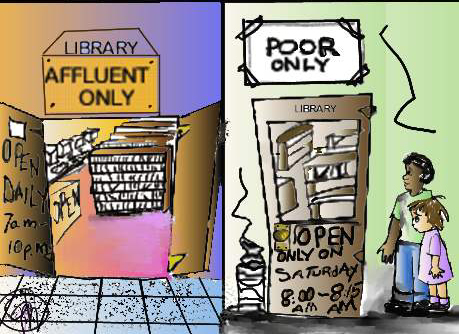In nations where school choice is available, students from poorer families are getting an inferior education as the school system becomes more segregated along socio-economic lines.

image courtesy of susanohanian.org
In many nations school choice has led to an increased segregation of schools based on class, race or ethnicity. For example a recent US study found parents tend to choose schools on the basis of the race and class composition of the school.
New Zealanders were once proud of their equalitarian education system. However a system of school choice designed to promote competition between public schools resulted in a school system that was more inequitable than most industrialised nations and far more segregated on the basis of race, socio-economic status and student performance.
 From 1991, following the recommendations of the taskforce headed by supermarket magnate, Brian Picot (pictured), NZ school children no longer had to attend their local school. Schools were expected to compete with each other for enrolments, which formed the basis of their funding. There was also provision for groups of parents to withdraw their children from an existing public school and establish their own public school that would be funded according to the number of students they could attract.
From 1991, following the recommendations of the taskforce headed by supermarket magnate, Brian Picot (pictured), NZ school children no longer had to attend their local school. Schools were expected to compete with each other for enrolments, which formed the basis of their funding. There was also provision for groups of parents to withdraw their children from an existing public school and establish their own public school that would be funded according to the number of students they could attract.
Parents tended to choose schools on the basis of their ethnic mix and socio-economic status, assuming that schools with fewer Maori and Pacific Islander children, and fewer poor children, would be better quality. Popular schools were able “to choose academically motivated students from relatively affluent families.” Maori children were “significantly less likely” to be accepted into their first choice of school than other children.
At the same time schools in working-class areas tended to be destabilised as upwardly mobile families moved their children to other schools in more affluent neighbourhoods causing a decline in enrolments, and therefore funding cuts and teacher cuts and, in some cases, a “spiral of decline”. At the same time these declining schools became the refuge for “increasing concentrations of difficult-to-teach students, including those suspended from other schools.
By 1998 it was clear to everyone, even government officials, that the market system did not work for poorer schools. They could not improve their enrolments no matter how much they improved their teaching quality and how well they ran their schools, because of parental prejudice. Marketing efforts and efforts to accommodate parental needs through provision of extras such as after-school programmes did not help. They found it hard to attract qualified teachers. The causes of their downward spiral were beyond their control.
If you have any examples or updates you would like to contribute please email them to me and I will add them here. Please give references for where you sourced the information.